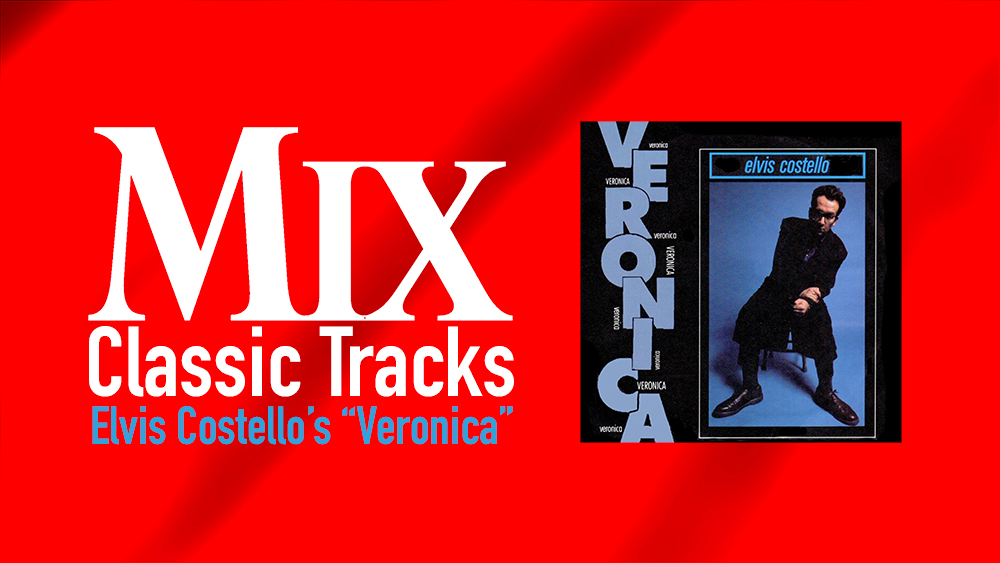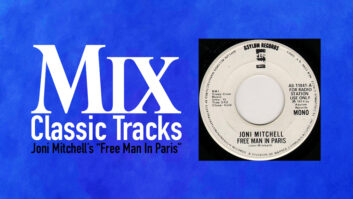
In his recent memoir, Unfaithful Music & Disappearing Ink, Elvis Costello writes—among many other things—about the impact that The Beatles had on his musical life: “Please Please Me” got him fired up about rock ’n’ roll when he was nine. He counts a complete set of Beatles autographs among his musical treasures. He made the ambitious, beautiful album Imperial Bedroom with Beatles engineer Geoff Emerick in 1982. And Costello wrote and recorded his highest-charting single to date, the Number One Modern Rock song “Veronica,” with Paul McCartney.
“When I’d got the call to say Paul wanted me to write some songs with him for his next record, I didn’t know what to expect,” Costello writes, “but as his last co-written hit had been with Michael Jackson, I wondered whether I should be taking some dancing lessons.”
Fortunately, great moves were not required for this collaboration. Costello’s writing sessions with McCartney took place above McCartney’s East Sussex studio, where the two artists were “sitting on two couches across a low table with a pen, a notepad, and a guitar apiece,” Costello writes. “Bill Black’s upright bass, the one with the white piping that you see in early stage pictures of Elvis Presley, stood in the corner like a good-luck charm.”
Both arrived with partially completed songs, some of which later landed on McCartney’s Flowers in the Dirt album (1989, Parlophone), and others that became part of Costello’s album Spike (1989, Warner Bros.).
“I’d brought an early draft of ‘Veronica’ that you would have recognized, but we immediately got to work putting a better flow into the chorus and shifting the bridge into making that part of the song seem more like a dream,” Costello explains in his autobiography. “All of the words that I’d already written were about my paternal grandmother, Molly, or more formally, Mabel Josephine Jackson. In fact, her Catholic confirmation name, Veronica, provided the very title of the song.”
Costello’s grandmother had suffered from dementia, and the dreamlike qualities of the song lyrics and the arrangement (and the MTV Video Music Award-winning video) reference the confused, irregular flashes of her memory. But the recording somehow turns this dark, fragmented subject matter into a bright, sparkling pop song.
“In our initial discussions with [Spike co-producer] T Bone Burnett and Elvis and myself, we all felt that ‘Veronica’ was the best opportunity to have a single on the record,” recalls Spike engineer and co-producer Kevin Killen. “We said, ‘Let’s do everything we can to make it undeniably great and infectious’; every decision was made to maximize that impact. Generally speaking, tonally, we wanted something that was bright but also had a lot of resonance in terms of how the vocal was perceived.”
The diverse, 15-track album Spike was to be the first Costello made under a new deal with Warner Bros. Records. That’s likely one of the reasons that the artist went into this project with even more lofty goals than usual, and with a commitment to creating at least one big single for the album. Recording sessions for Spike began with the songs “Any King’s Schilling” and “Tramp the Dirt Down” in Dublin and then moved to New Orleans, where Costello and company worked with the Dirty Dozen Brass Band and Allen Toussaint on further tracks.
Then the team decamped to L.A., where the remaining songs were laid down in Ocean Way Studio 2. “That was one of T Bone Burnett’s favorite rooms, and the very first time I worked there, I realized why,” Killen says. “It has a very particular sound that’s very warm. It had a great Neve 8038 console; without exaggeration, almost anything you put through that console sounded wonderful.
“And then Allen Sides, who was still the owner at the time, had a really good monitoring system in that room,” Killen continues. “He coupled Altec speakers with some midrange drivers—they might have been JBLs—and connected them to McIntosh amplifiers. But it wasn’t just the combination of components; it was the way the room was constructed. The soffiting in the control room was of a particular type that Allen had overseen, and he made sure the imaging and energy that was coming from the speakers was directed at the listening position, which gave a very accurate picture.”
Whereas many of the songs on Spike started with live basic tracking, followed by overdubs, “Veronica” was built in layers, starting with a drum machine pattern and Costello and Burnett playing acoustic guitars. “I would have used a combination of a [Telefunken] 251 microphone to get the full body and probably a [Neumann] KM 84 to get a little bit of sparkle out of the guitar,” says Killen.
Next, Mitchell Froom added his Wurlitzer; the speaker cabinet was miked with two Sennheiser MD421s. Froom also added DI’d electric piano and Chamberlin parts. “That Chamberlin part is the little trumpet sound in the middle of the two verses,” Killen reveals.
“Then we had Benmont Tench come in to play piano and the little tinkly spinet part. And then Elvis went in to do a vocal. He likes to do vocals quite early in the process, so this was maybe the second day. Then the next day he redid it. It was probably just one pass for him to get himself set, and then the second or third pass usually is the take. And then, of course, he quickly did the harmony background parts. He’s excellent at harmonizing with himself.”
Costello’s vocal mic was a Neumann U 47. “We always used a particular one that he sounded great on, to an LA-2A, and all the mic pre’s we used were the ones on the console, which were 1073s,” Killen recalls.
Killen and the musicians kept filling up the Ampex ATR124 tape machine, track by track. “After the vocals, we added Michael Blair’s percussion part: the timpani part in the chorus, which is part of the hook—that little accent that comes in. That’s a slight homage to Burt Bacharach, whom Elvis adored but, up to this point, had not worked with yet.
“Mitchell and I had both worked with Jerry Marotta and we knew that he was going to be in Los Angeles,” Killen continues. “We invited him over to play on that song. At the time, I was just in love with piccolo snares. Most of the other snares and other drum sounds on the record were slightly thicker or deeper sounding, and we wanted something that had a real pop to it—something that didn’t take up lot of space but had a real signature to it. So we chose a little piccolo snare, and as soon as Gerry started playing the part, Elvis looked at me with the broadest smile on his face and said, ‘That’s fantastic!’”
Marotta also contributed the idea of holding off the bass drum until the second half of each verse. “It’s such a hook,” Killen says. “You don’t even think about it, and then it comes in, and it’s another infectious hook within the layers of the arrangement that propels it and keeps your attention.”
Killen’s go-to drum-miking scheme at the time included an Electro-Voice RE20 and AKG D112 on kick, SM57s on snare top and bottom, 421s on tom toms, a Neumann KM 84 on hi-hat, Telefunken Elam 251 for overheads, and two Neumann U 67 room mics.
Once all the songs had been completed at Ocean Way, the team made their way to London to record the last piece of the arrangement: Paul McCartney’s Hofner bass, which was captured with a DI at AIR Studios. “It was an interesting process to work on a song with no bass throughout, and then hear the bass part as the final overdub,” Killen says. “His part is undeniably great. It helps complete the track.”
Mixing for Spike then began at AIR, but a booking conflict soon sent everyone back to Ocean Way, where most of the songs, including “Veronica,” were mixed on the Neve 8038.
“That studio was really intended to be a recording studio, not a mixing studio, and that console had no automation,” Killen says. “So we basically mixed this whole album by hand—very old school. We pulled the half-inch machine up close to us and went through the arrangement and figured out: This is how the introduction’s going to go, this is how the first verse is going to go, etc. We had myself, Elvis, T Bone, and our wonderful assistant Mike Ross manning faders, going section by section.”
On “Veronica,” one of the elements created during the mix was the dreamy, phased-sounding bridge that starts with the lyrics, “On the empress of India…” “We set about offsetting two tape machines and did the old flanging/phasing with two tape machines running side by side,” Killen says.
Another element that makes “Veronica” pop is the juxtaposition of more gentle, harmonized vocals in the verses with the more strident singing in the chorus. The shift from one vocal style to the next is arresting but never jarring, and Killen’s approach offers insight into his mixing philosophy in general, as well as into the specific song:
“I’m always very conscious of what happens in the center of the image,” Killen says. “I try to keep as many of the instruments as possible out of the center image so I can keep that space available for the vocal, and part of that trick is to pan things slightly—not just off center, but even hard left and hard right so the only things that were in dead-center were the kick drum, the snare, the bass, and vocals.
“So, tonally, the more strident part of Elvis’ vocal sits in a certain frequency range and the sweeter, lower part can sit directly beneath it, and there’s very rarely any conflict between them. The question then becomes, how do they sit in combination with the kick drum and the bass. But Paul’s part is very active, so it’s never holding a note long enough for it to clash or be in conflict with either vocal part.
“We were also conscious of the fact that if a part exists, it has to have its space. It makes its appearance and then it leaves, like the baton is being passed from one instrument to the next. This song is really good example of that. It’s a brilliantly written and executed pop song, and when you listen, it takes you on quite a little journey from top to bottom.”







